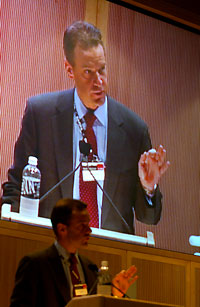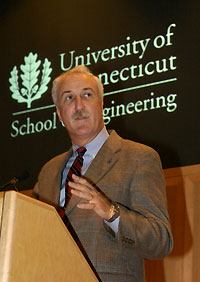|
This is an archived article.
For the latest news, go to the
Advance Homepage
For more archives, go to the Advance Archive/Search Page. | ||||
|
Tech Experts Say Human Element Can't Be Ignored Developing appropriate technologies for homeland security is important, but addressing the human dimension poses an even greater challenge, according to Sean O'Keefe, NASA administrator. O'Keefe spoke September 26 to an audience of academics, business people, and government officials in the auditorium of the new Information Technology Building, during a two-day International Conference on Advanced Technologies for Homeland Security that was sponsored by the School of Engineering.
The terrorist attacks of September 11 forced Americans to think for the first time about dangers other parts of the world have had to confront for a long time, O'Keefe said. "We're 25-30 years behind in this kind of approach," he said, "compared with so many other parts of the world." Many advanced technologies that were developed for peace-time activities such as travel and commerce are being adapted for the very different context of homeland security. One example of a technological application NASA has been involved in developing is 'refuse-to-crash technology,' that would prevent any pilot from guiding an airplane into an object, such as a building or a mountain. Yet many pilots are reluctant to use technology that would prohibit them from maintaining a course. "There are not only technological applications, but also a human dimension," O'Keefe said. Another challenge in dealing with homeland security, he said, is the need to coordinate the activities of large numbers of people who are not used to working together. After the Feb. 1 loss of the Shuttle Columbia, for example, it took a massive human effort, combined with the use of technology, to contain the risk to public safety and to reconstruct the cause of the accident. About 80,000 tons of toxic debris from the shuttle were scattered over about 750 acres in Louisiana, an area roughly the size of the state of Rhode Island. "We treated it as the equivalent of a chemical attack," he said. "We had to contain it rapidly, so individuals would not be harmed." For a period of 100 days, 250,000 people from many different organizations walked over every square foot of the affected area. "It was incredible to see the level of coordination, the level of cooperation," O'Keefe said. "We thought everyone would go off fighting about jurisdictions," as had happened after the Challenger tragedy. Information about each piece of debris that was collected and where it was found was entered into a database. The shuttle's flight recorder was soon recovered and experts were able to reconstruct how the accident happened. The coordination that went into this effort has become the topic of a major study, he said. The role of human beings in relation to technological advances was also the theme of a panel discussion September 25 in the Lewis B. Rome Ballroom. Robert Popp, acting director of the Defense Advanced Research Project Agency (DARPA) and a UConn graduate, said one of the barriers to implementing technological advances is that the policy process moves more slowly than the technology. "One great example is the information policy associated with privacy protection," said Popp, who manages the Terrorism Total Information Awareness program for the military and government. "The privacy model that we see largely in place today reflects a world of the 1970's. But the technology base, especially in the information technology world, was very different in the '70s than it is today. Moreover, the national security landscape of today is dramatically different. "Policy makers often don't have a good understanding of the technology that comes out of research and development when making their policy decisions," he said. Hugo Poza, vice president of Homeland Security for the Raytheon Co., agreed. "We have all the tools in the intelligence world that we need, but little process as to what the limitations are in their use. It's similar to the use of a gun. You can legally have a gun, but it doesn't give you the liberty to use it to kill someone." Bruce Schneier, founder and CTO of Counterpane Internet Security Inc., said technologists often don't understand security as a system. "Imagine you're building a bank vault," he said. "It's all well and good to talk about a few inches of steel between the bank robbers and the money, but when you start looking at the system it's a much more complicated question: Who knows the combination? What if he's sick? What if he's fired? How does the combination change? Who installed the safe? Is there an alarm? Who responds if the alarm goes off? What if it's a false alarm?" Schneier said how systems fail is "far more important than how they succeed. Think about hazardous screening at an airline. The system can fail in two ways: you can let the bad guys through or you can keep the good guys out. Every time that system takes away a nail clipper from a grandma, that system has failed." Schneier said the agenda of the people involved in implementing a system and using it is more important than the system itself. Pilots, flight attendants, the airlines, and passenger advocacy groups may all have different political, social, and economic agendas. "These will make an enormous difference in what they're willing to deploy, and in what they're willing to accept," he said. Robert Tuohy, senior director of strategic planning for Hicks and Associates Inc., said lack of experience is the biggest barrier to implementing technology for homeland security. "Since September 11, 2001," Tuohy said, "we have a new set of foot soldiers to protect our country. For years, the national security environment was that soldiers, sailors, airmen, and the marines were the front lines of national defense." Now, he said, "other groups have become important, such as emergency responders who are not employees of the federal government." |


